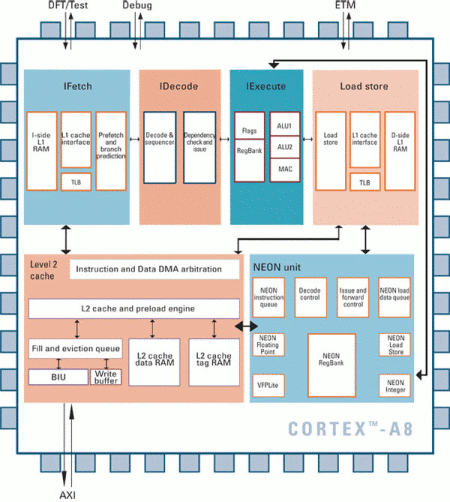Cortex-A8 core runs faster, sips power
Jul 27, 2009 — by LinuxDevices Staff — from the LinuxDevices Archive — 29 viewsSamsung and Intrinsity say they have created “the industry's fastest mobile processor core implementation” of the ARM Cortex-A8 architecture. SoCs based on the implementation — code-named Hummingbird — will use a 45-nanometer (nm) production process, run at 1GHz, and feature extremely low power leakage in sleep mode, the companies say.
Samsung has been a licensee of ARM's Cortex-A8 core since its 2005 introduction. At the time, the A8, which uses the ARMv7 instruction set, was touted as ARM's highest-performance, lowest-power design yet, targeting cell phones, media players, and other mobile devices. Typical Cortex-A8 implementations, such as the Texas Instruments (TI) OMAP35xx line of system-on-chips (SoCs), or Freescale's i.MX51x family, use a 65nm production process and are clocked at 600MHz.
Last September, Samsung signed an agreement with Texas-based Intrinsity, Inc., intended to result in low-power processors using the latter's "Fast14" technology. According to Intrinsity, Fast14 technology combines 1-of-N Domino Logic (NDL), custom and semicustom static logic, high-speed memory technology, specialized low-power design techniques, and a design automation platform, adding up to "the best available combination of speed, power and silicon area."
SoCs based on the Hummingbird core will employ Samsung's 45nm production process and clock at 1GHz, delivering 2000 Dhrystone MIPS, says Samsung. The SoCs will employ enhanced logic that is "cycle-accurate and Boolean equivalent to the original Cortex-A8 RTL [register transfer level] specification," but is said to replace the typical synthesized static logic with Intrinsity's proprietary NDL. It's claimed that NDL gates can operate 25 to 50 percent faster than static logic gates.
The Hummingbird will also use power-saving techniques, including aggressive clock gating, power gating, variable voltage/frequency scaling, optimized Vt selection, and power efficient on-chip communication, the companies say. In addition, SoCs based on the Hummingbird core will offer "low leakage," meaning that little current is being leaked when a device is in sleep mode, the companies say.
While neither Samsung nor Intrinsity released power consumption figures, an EETimes report claims that the Hummingbird will use approximately 640mW while running at 1GHz.
Dr. Jae Cheol Son, VP for SoC platform development in Samsung's System LSI division, stated, "The biggest challenge in mobile processor core design and implementation is to achieve high clock speed performance while keeping the power consumption low. Samsung's forthcoming SoC products which are based on the Hummingbird will enable our customers to add many more advanced processing capabilities to their mobile products without sacrificing battery life."

Block diagram for ARM'S original Cortex-A8
(Click to enlarge)
When it debuted the Cortex-A8 in 2005, ARM touted the core's "advanced superscalar pipeline" that can execute multiple instructions simultaneously, to deliver "more than 2.0 DMIPS per MHz." The processor integrates a size-configurable, power-optimized L2 cache, which works in conjunction with fast 16KB or 32KB L1 caches to minimize access time and maximize throughput, the company says. When built on 65nm processes, a barebones A8 core without L2 cache can fit in as little as four square millimeters of silicon, ARM adds.
The A8 was the first of ARM's own processor designs to integrate its Neon integer and floating-point pipelines for media and signal processing. When ARM announced Neon in October of 2004, it said chips supporting Neon instructions could decode an MP3 stream in 8-10MHz. Neon is claimed to help the A8 deliver a four-fold improvement per clock cycle over media processing capabilities in ARM9-class processors.
Another new feature in the A8 was a "Jazelle-RCT" instruction set for Java. McGuire explains, "ARM11 and ARM9 supported Jazelle-DBX, or "direct bytecode execution." The A8 supports Jazelle-RCT, tailored to work with the ahead-of-time compilation in technologies like Java. The A8 also includes ARM's TrustZone extension, aimed at DRM (digital rights management) and other high-security applications.
Cortex goes multi-core: Cortex-A9
Later this year, SoCs are expected to arrive in limited samples equipped with a multi-core spin-off of the Cortex-A8 called the Cortex-A9. While Cortex-A8 is touted as being three times faster than ARM11, Cortex-A9 is claimed by ARM to offer "four to 16 times more" performance.
The speed boost derives in large part from the A9's 45nm fabrication process and the use of MPCore interconnect technology, which is claimed to support SoC designs with up to four A9 cores. The first announced SoC based on the Cortex-A9 is TI's OMAP4x, but it appears that NXP may also have a Cortex-A9 SoC waiting in the wings.
Availability
Samsung said it will put the Hummingbird core into "mobile SoC products," but did not provide a timetable or other details. Like other ARM-based SoCs, the devices are likely to run Windows CE, Windows Mobile, and Linux. For its part, Intrinsity suggested that its technology could be available in new parts within approximately six months.
To read the EETimes.com report alluded to earlier in this story, see the publication's website, here.
This article was originally published on LinuxDevices.com and has been donated to the open source community by QuinStreet Inc. Please visit LinuxToday.com for up-to-date news and articles about Linux and open source.